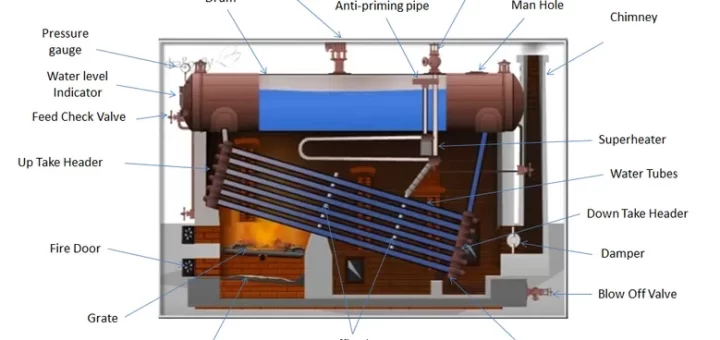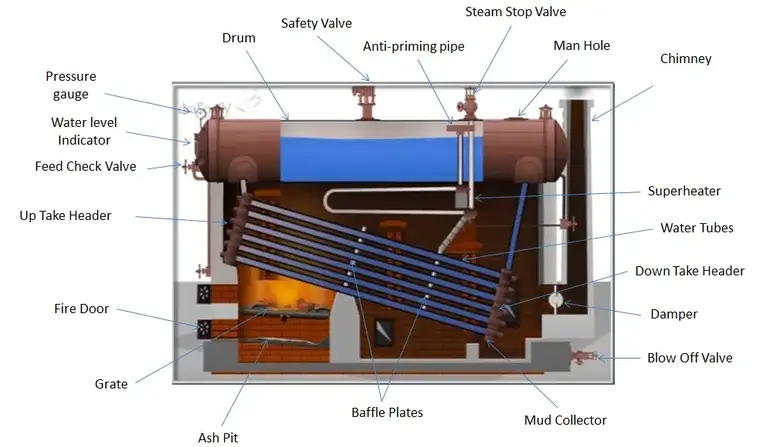What is Babcock and Wilcox Boiler ? – Complete Explanation

What is Babcock and Wilcox Boiler ? – Complete Explanation
Leave a Comment / Boilers, Thermal Engineering / By Pankaj Mishra
In this article, you will learn about Babcock and Wilcox Boiler- Main parts, working, advantages, and disadvantages with the application. This boiler is generally used to produce high pressure steam, and this high-pressure steam is used to produce electricity in power generation industries. It is also used in the area where high pressure steam is required. So let’s begin our journey to do a detail study about it.
Table of Contents
- What is Babcock and Wilcox Boiler?
- Construction of Main Parts
- Working of Babcock and Wilcox Boiler
- Application
- Advantages
- Disadvantages
What is Babcock and Wilcox Boiler?
It is a Horizontal drum axis, natural draft, natural circulation, multitubular, stationary, high pressure, solid fuel fired, externally fired water tube boiler.
It was discovered by George Herman Babcock and Stephen Wilcox in the year 1967. And if was named after its discoverer as Babcock and Wilcox boiler.
Construction of Main Parts

The various main parts of Babcock and Wilcox Boiler are as follows
1. Drum:
It is horizontal axis drum which contains water and steam.
2. Down Take Header:
It is present at rear end of the boiler and connects the water tubes to the rear end of the drum. It receives water from the drum.
3. Up Take Header:
It is present at front end of the boiler and connected to the front end of the drum. It transports the steam from the water tubes to the drum.
4. Water Tubes:
They are the tubes in which water flows and gets converted into steam. It exchanges the heat from the hot flue gases to the water. It is inclined at angle of 10-15 degree with the horizontal direction. Due to its inclination the water tubes do not completely filled with water and the water and steam separated out easily.
5. Baffle Plates:
Baffle plates are present in between water tubes and it allows the zigzag motion of hot flue gases from the furnace.
6. Fire Door:
It is used to ignite the solid fuel in the furnace.
7. Grate:
It is a base on which the burning of the solid fuel takes place.
8. Mud Collector:
It is present at the bottom of the down take header and used to collect the mud present in the water.
9. Feed Check Valve:
It is used to fill water into the drum.
10. Damper:
It regulates the flow of air in the boiler.
Also Read:
- What is Gas Turbine Power Plant?
- Locomotive Boiler – Construction Working and Application with Diagram
- Cochran Boiler – Main Parts, Working, Advantages and Disadvantages
The various boiler mounting and accessories used in this type of boiler are:
- Superheater: It increases the saturated steam temperature to the required temperature before discharging it from the steam stop valve.
- Pressure Gauge: It is used to check the steam pressure within the boiler drum.
- Water Level Indicator: It shows the level of water within the drum.
- Safety Valve: It is a valve which acts when the pressure of steam within the boiler drum increase above the safety level. It opens and releases the extra steam in the environment to maintain the desired pressure within the boiler.

Working of Babcock and Wilcox Boiler
Now let’s discuss the working of the Babcock and Wilcox boiler step by step.
- First, the water starts to come in the water tubes from the drum through the down take header.
- The water present in the inclined water tubes gets heated up by the hot flue gases. The coal-burning on the grate produces hot flue gases, and it is forced to move in a zigzag way with the help of baffle plates.
- As the hot flue gases come in contact with water tubes, it exchanges the heat with water and converts it into steam.
- The steam generated is moved upward, and through the uptake header, it gets collected at the upper side in the boiler drum.
- An anti-priming pipe is provided in the drum. This anti-priming pipe filters the water content from the steam and allows only dry steam to enter into the superheater.
- The superheater receives water-free steam from the anti-priming pipe. It increases the temperature of the steam to the desired level and transfers it to the steam stop valve.
- The superheated steam from the steam stop valve is either collected in a steam drum or made to strike on the steam turbine for electricity generation in the steam power plant.
For Better Explanation of Working of Babcock and Wilcox Boiler, Watch the Video Given Below:
Application
The Babcock and Wilcox boiler are generally used to produce high-pressure steam in power generation industries. The high-pressure steam so generated is used to produce electricity.
Advantages
- Steam generation capacity is high. It is about 2000 to 40000 kg/hr.
- It occupies less space.
- Replacement of defective tubes is easy.
- It is the only boiler that is used to generate a large quantity of heat in power stations.
- The draught loss is minimum.
- Inspection of this types of boiler can be done anytime during its working.
Disadvantages
- High maintenance cost.
- It is not much suitable for impure and sedimentary water. In the case of impure and sedimentary water, the scale may deposit in the tubes and this leads to overheating and bursting of tubes. That’s why water treatment is must before feeding into the boiler.
- A continuous supply of feed water is required for working. In the case, if feed water is not continuously supplied even for a short period of time, the boiler gets overheated. The water level must be carefully watched during the operation of the Babcock and Wilcox boiler.
